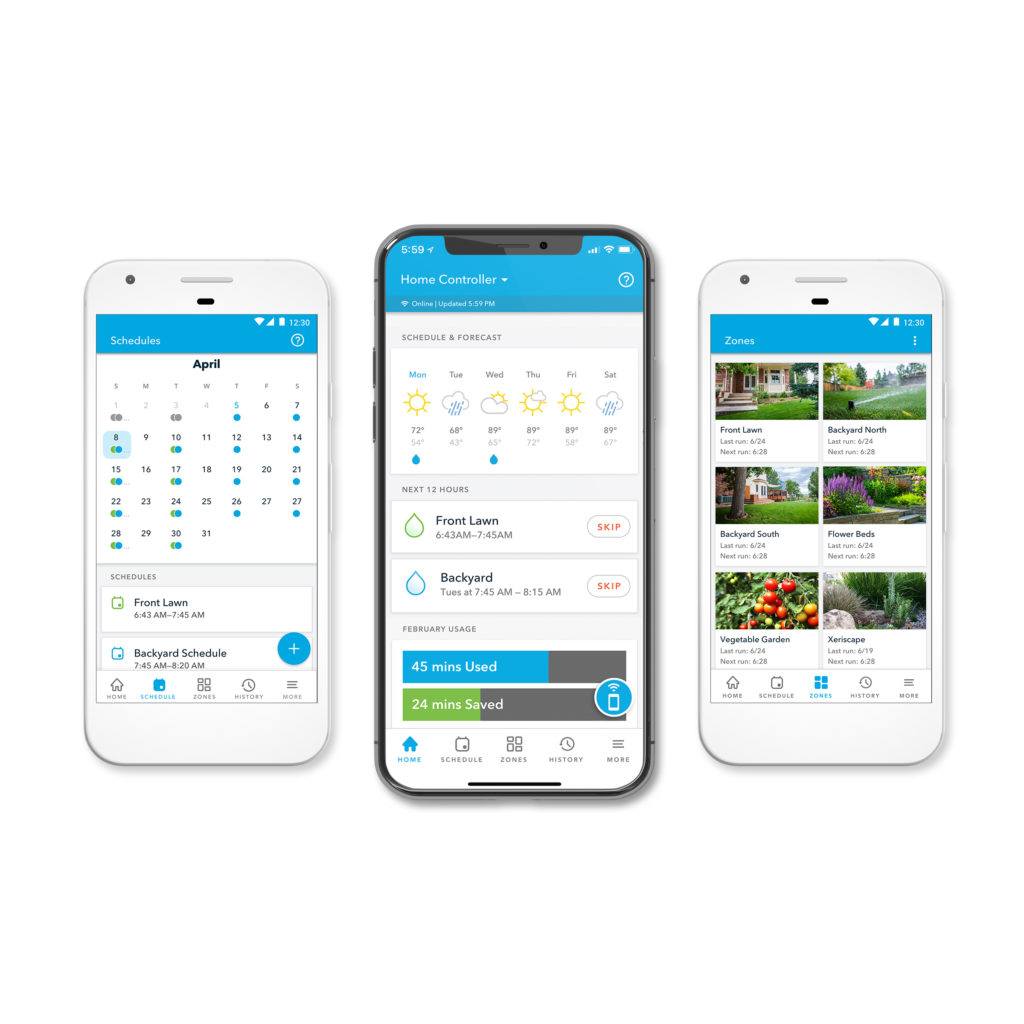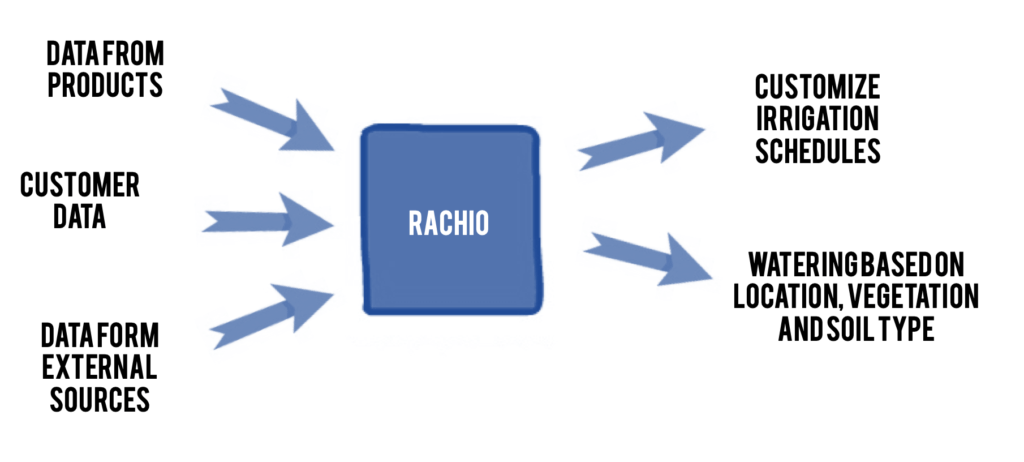Combining different data sources creatively

Rachio is a company that sells smart irrigation system controllers and creatively combines data from different sources to provide integrated services for its customers.
In 2012 Christopher Klein (CEO), Franz Garsombke (CTO), and Matthew Reisman found Rachio in the hopes to commercialize a smart-sprinkler called Iro (Ear-o). Based in Denver, Colorado, Rachio is a hardware and software firm focused on improving the water efficiency of private gardens. Iro, the star product, automatically adjusted customer irrigation systems to improve water consumption according to changes in weather [1]. The company mission states [2]:
“We believe people want beautiful, meaningful landscapes and also want them to be sustainable. This requires a unique balance of proper vegetation, landscape architecture, infrastructure, and smart controllers. Our intelligent sprinkler controller is just the start. We believe water can be sustainably used throughout our homes. We’ll continue to build things to ensure it is.”
Rachio competes with companies such as Rainmachine, Orbit, Netro, and Hunter in the global smart irrigation controllers’ market. This market is projected to grow by US$1.3 Billion, reaching $2.8 Billion by 2026, and growing at a CAGR of 17.5% from 2018 to 2026 [3; 4].
To sustain its mission, Rachio has raised a total funding amount of $20.5M ($10M – Series B) from investors since 2014 and has been continuously expanding its market share, including leveraging Amazon to sell its products. To date, Rachio counts more than 50 employees who are working to upgrade its value proposition and to make sustainable domestic water use effortless. Following this principle, Rachio estimates to have saved more than 20 bn gallons of water between 2014 and 2018. CEO and Co-Founder Chris Klein remarked:
“Rachio is not only saving homeowners frustration, water, and money, we are helping communities conserve water on a much larger scale. With more than 60% of residential water waste in the United States occurring outdoors, our new products empower consumers to be smarter with water, so they don’t have to choose between conservation and easily maintaining a beautiful landscape.”
Rachio 3 – Smart irrigation system
On March 20, 2018, a new product named Rachio 3 was released and priced for $279.99 on Amazon.

Via a smartphone interface, Rachio 3 allows customers to customize irrigation schedules and consumptions in their gardens. Indeed, Rachio’s app takes the guesswork out of watering by evolving local weather data to determine exactly the days and times for watering based on location, different plant needs, and soil type.
The Amazon-certified sprinkler’s controller plugs into any pre-existing irrigation system, allowing the customer to continue to use the existing sprinkler heads and pipes. It also works with everyone’s favorite smart home system and voice services, including Amazon Alexa. Paul Bernard, Director of Amazon’s Alexa Fund, which has contributed to the Serie B fundraising, revealed:
“We’re excited to make a follow-on investment in Rachio as they continue their growth and innovation in sustainable solutions for the smart home. Hands-free voice control is making the smart home simple and convenient for customers. Rachio’s Alexa skill makes it easy for customers to control their intelligent sprinklers simply using their voice, helping to improve water efficiency in the home.”

Combining different data sources creatively
Going forward with the analysis, Rachio needs to integrate three different sources of data on the whole [2]:
- Data from products: Rachio provides its customers with four types of sensors (i.e. Rain sensors, Soil sensors, Wired Flow sensors, and Flow Meter) which collect data in real-time.
- Data from enterprise sources: this data comes mainly from sales and aftersales, like complaints or reviews.
- Data from external sources: as the weather forecasts or logistics information, they belong to external datasets that the company can access. Data can also be collected and integrated from other home devices.

If we consider this pattern from another angle, Rachio creates value by combining diverse types of data in creative ways to be delivered then as services. That is the reason why customers are buying the product.
However, it is worth noticing that despite the great investment in the variety of services, Rachio doesn’t capture value from the services it provides. In their plug and play model, the customer pays only for the hardware as an entrance fee to join an environment built upon data flows, and that is still free to navigate.
Sources
[1] https://www-bizjournals-com.ezp-prod1.hul.harvard.edu/denver/news/2018/07/10/2018-q2-venture-capital-denver-boulder.html
[2] https://www.rachio.com/
[3] https://www-marketresearch-com.prd2.ezproxy-prod.hbs.edu/feed/factiva/display.asp?productid=12668911
[4] https://www-bizjournals-com.ezp-prod1.hul.harvard.edu/denver/news/2018/01/03/smart-home-tech-startup-raises-a-new-vc-round.html



That’s interesting that in this case, private gardens, which are rather a hobby are somewhat ahead of industrial agriculture.
It also reminds me of an interesting startup for city gardens: https://www.growsquares.com/#/
Such an incredible idea! It makes me wonder how many other applications can benefit from an amalgam of data from several sources. In particular, many underexploited niche markets with low TAM can likely benefit from finding and aggregating complementary data sources.
If Rachio relies so heavily on data from external sources (with potentially constantly changing APIs, or even no well-defined APIs), how do they ensure sustainability of this strategy? Will they have to rely on teams of all-star engineers and data scientists to constantly recalibrate changing datasets and ensure that the results seen by all the customers are repeatable and consistent?